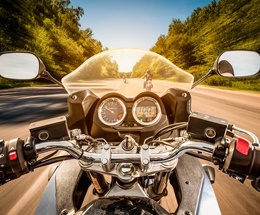 Another sign that warm weather is here is the roar of a motorcycle as it drives down your street. It's always been my dream to own a motorcycle. A new motorcycle was going to be a gift to myself when I turned 30, then 40, and now it will have to wait until 50. My dream finally became a reality at 51.
Another sign that warm weather is here is the roar of a motorcycle as it drives down your street. It's always been my dream to own a motorcycle. A new motorcycle was going to be a gift to myself when I turned 30, then 40, and now it will have to wait until 50. My dream finally became a reality at 51.
Like many things in life, a motorcycle must be respected by the rider and other motorists who share the road. Motorcycles are small, hard to see, and fast. Without proper training and a basic understanding of how they work, serious and dangerous situations can arise. Unfortunately, motorcyclists are 26 more times likely to die in a crash and five times more likely to be injured than car occupants.
Here are some tips on how you can safely share the road with motorcycle riders.
- Don’t be a bully. If you drive a larger vehicle, like a pickup or SUV, you may feel a bit aggressive when a motorcycle is in your way. Following at a close distance in an attempt to motivate them to go faster or get out of your way isn't wise. This creates dangerously-short braking distances. In addition, it may cause the motorcycle rider to become stressed and pull an unsafe maneuver. Everybody has the same right to be on the road. If you end up following a motorcycle, maintain a distance of at least four seconds.
- Double check your blind spots. Because of their speed and size, motorcycles may quickly come in and out of your blind spots. Always take a second look now that motorcycles are out on the road.
- Be courteous. If you're annoyed because a driver isn't driving at your speed or if a blinker has been blinking for miles, take a couple of deep breaths. Little mistakes happen. If we blow them out of proportion, there can be dangerous consequences.
- Be cautious when turning left. Making a left turn can be tricky, especially when traffic volume is heavy. You may have difficulty seeing due to sun glare, or because another vehicle is making a left turn opposite of you. You also have to watch for pedestrians in the crosswalk. In addition, don’t forget about a motorcyclist. Most accidents between a car and motorcycles occur in intersections. Due to a motorcycle's small size, we just don’t see them. When making a left turn, scan the intersection to determine what's happening. Then scan again looking specifically for motorcycles. If everything looks good, safely make your left turn.
- Allow adequate following distance. When it comes to slowing down, motorcyclists may not use their brakes immediately, so don’t expect to see brake lights. Motorcyclists may reduce speed by relaxing the throttle or downshifting so the speed will drop without ever touching their brakes.
- Focus. Focus on driving and paying attention to what's going on outside your vehicle. Eliminate distractions inside your vehicle.
If you're a new rider or thinking about starting to ride, here are some tips for you.
- Enroll in a class. Once you made the decision to ride, consider enrolling in a class. Basic rider classes, such as the one offered at Road America, teach basic riding skills in a safe controlled environment. They even provide the motorcycles! This is a great way to find out if riding is for you before making the purchase. The other benefit is that after you complete the course, you earn a motorcycle license. There's no need to take a road test with your local Department of Motor Vehicles (DMV). To find a class near you, visit the Motorcycle Safety Foundation.
- Practice, Practice, Practice. After completing the basic rider’s class, continue to practice. Riding in a quiet neighborhood allows you to continue to learn how the motorcycle handles without heavy traffic. The more you ride, the more comfortable you'll be. In addition, riding in a quiet neighborhood during different weather conditions will help you learn additional driving skills.
- Remain alert. When driving a motorcycle, extra attention is needed. Constantly scan the environment for changing conditions. Pay attention to what the cars around you are doing, and watch for pedestrians and darting animals.
- Avoid drowsy driving. Never drive a motorcycle if you're tired or under the influence of drugs or alcohol. All these things can slow down your reaction time and cause a crash.
- Make sure you're seen. Because of the size and speed of motorcycles, your visibility may be limited to other motorists around you. Wear bright clothing and put reflective material on your motorcycle or clothing. Also, position yourself in your lane so you're more visible to other motorists.
Do you have any tips or information you’d like to share? I’d love to hear them; please share them in the box below.
Source:
https://www.msf-usa.org/





